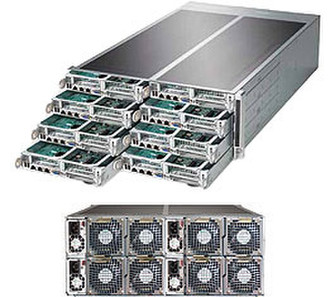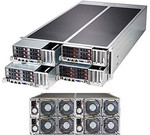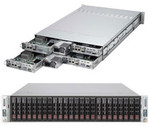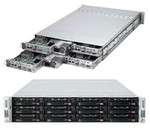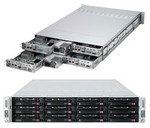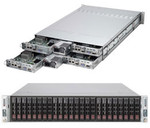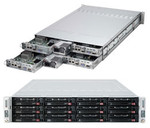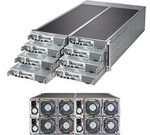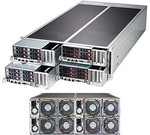基本輸出輸入系統/BIOS
| BIOS的高级配置管理规范 |
2.0 |
| BIOS内存大小 |
128 MB |
| 基本输入输出系统类型 |
AMI |
| BIOS 特点 |
APM 1.2, PCI 2.2, Plug & Play, SMBIOS 2.3, UEFI |
端口 & 界面
| 串口数量 |
1 |
| IPMI LAN端口(RJ-45) |
Y |
| SATA III连接器数量 |
2 |
| VGA(D-SUB)端口数量 |
1 |
处理器
| 可支持处理器数量 |
2 |
| 最大缓存 |
30 MB |
| 系统总线类型 |
QuickPath Interconnect (QPI) |
性能
| 背板支持 |
Y |
| 智能平台管理接口(IPMI)支持 |
Y |
| 光驱类型 |
N |
内存参数
| 内存格式因素 |
240-pin DIMM |
| DIMM插槽数量 |
16 |
| 数据宽度 |
72 bit |
| 错误更正代码 |
Y |
| 支持的内存类型 |
DDR3-SDRAM |
| 内存电压 |
1.35, 1.5 V |
| 支持的DIMM大小 |
16GB, 1GB, 2GB, 32GB, 4GB, 8GB |
| 最大UDIMM内存 |
128 GB |
| 最大RDIMM内存 |
512 GB |
| 最大内部存储 |
1000 GB |
扩展槽
| PCI Express x16 插槽 |
1 |
| PCI Express x8插槽 |
1 |
| PCI Express插槽版本 |
3.0 |
联网
| 以太网的数据传输率 |
10, 100, 1000 Mbit/s |
| 局域网控制器 |
Intel I350, Realtek RTL8201N |
| 以太网铜缆技术 |
1000BASE-T, 100BASE-TX, 10BASE-T |
| 网路功能 |
Gigabit Ethernet |
存储介质
| 支持的硬盘驱动器大小 |
3.5 " |
| 支持存储驱动器界面 |
Serial ATA II, Serial ATA III |
| 热插拔硬盘驱动器托架 |
N |
| 支持的硬盘数量 |
2 |
能量控制
| 冗余电源供给设置数量 |
4 |
| 直流电(DC)输出电流(+5V) |
4 A |
| 直流电(DC)输出电流(+12V) |
150 A |
| 电源 |
1620 W |
| 输入电流 |
10.5 - 8 A |
另外
| 主板晶片 |
Intel C602 |
| 系统总线 |
8 GT/s |
| 以太网连接器 |
Y |
| 以太网路(RJ-45)连接接口数量 |
2 |
SuperServer F617R3-FT+, 8 Hot-plug System Nodes, 4U, Intel® Xeon E5-2600, 1TB ECC DDR3, 2 Fixed 3.5" SATA HDD Bays, 16x 240-pin DDR3 DIMM, 1 PCI-E 3.0 x16 (LP), 1 PCI-E 3.0 x8 (LP), Intel® C602 Chipset, 128Mb SPI Flash EEPROM AMI BIOS, 1620W Redundant, Black
The FatTwin™ is the latest addition to Supermicro's evolving line of Twin Architecture SuperServer® solutions. The 4U FatTwin greatly expands compute and storage capacities beyond Supermicro's existing 2U Twin2™ and 1U Twin™ SuperServer® systems to achieve increased performance with lower power consumption. By virtue of its shared components the FatTwin improves cost-effectiveness and reliability, while its modular architecture makes it flexible to configure and easy to maintain.
The FatTwin is available in high-density 8 / 4 / 2 hot-plug system node configurations with a choice of memory capacities, hard disk drives, power supplies, front or rear I/O, PCI and networking options and more. Its high efficiency, highly effective shared cooling architecture allows the FatTwin to operate in high-temperature, free-air cooled environments up to 47°C, providing considerable cost savings and improved TCO. Versatile configurations allow the FatTwin to be optimized for many different environments including Data Center, Cloud Computing, and HPC; Engineering, Research, and GPU projects; File and Storage Server deployments; and General Server and Enterprise Server applications.
The term Fat Twin is similar to other well-known IT industry expressions. For example, A Fat Tree Is a network topology that can be tailored to efficiently use any bandwidth made available by packaging and communications technology which has been widely used in the HPC environment. A Fat Client on the other hand is a computer in a client-server architecture that provides rich functionality independent of the central server. In this same manner, the FatTwin is a powerful yet flexible and highly scalable server system that provides extremely rich computing functionality representing the highest levels of energy efficiency and performance. With these enormous advantages, the Supermicro FatTwin represents a revolution in green computing designed to support customers' critical applications and also to reduce Data Center TCO and help preserve the environment.


